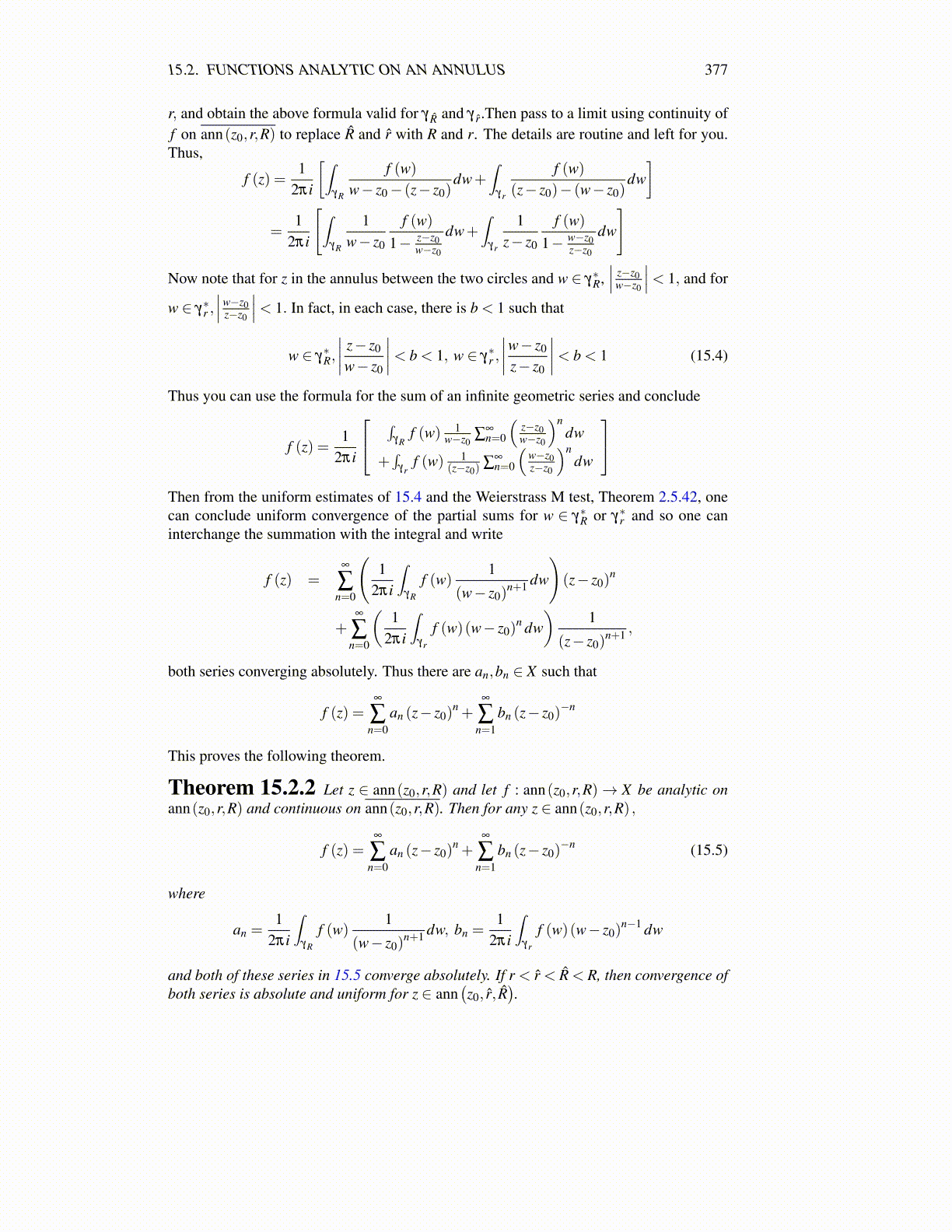
15.2. FUNCTIONS ANALYTIC ON AN ANNULUS 377
r, and obtain the above formula valid for γ R̂ and γ r̂.Then pass to a limit using continuity off on ann(z0,r,R) to replace R̂ and r̂ with R and r. The details are routine and left for you.Thus,
f (z) =1
2πi
[∫γR
f (w)w− z0− (z− z0)
dw+∫
γr
f (w)(z− z0)− (w− z0)
dw]
=1
2πi
[∫γR
1w− z0
f (w)1− z−z0
w−z0
dw+∫
γr
1z− z0
f (w)1− w−z0
z−z0
dw
]
Now note that for z in the annulus between the two circles and w ∈ γ∗R,∣∣∣ z−z0
w−z0
∣∣∣< 1, and for
w ∈ γ∗r ,∣∣∣w−z0
z−z0
∣∣∣< 1. In fact, in each case, there is b < 1 such that
w ∈ γ∗R,
∣∣∣∣ z− z0
w− z0
∣∣∣∣< b < 1, w ∈ γ∗r ,
∣∣∣∣w− z0
z− z0
∣∣∣∣< b < 1 (15.4)
Thus you can use the formula for the sum of an infinite geometric series and conclude
f (z) =1
2πi
∫γR
f (w) 1w−z0
∑∞n=0
(z−z0w−z0
)ndw
+∫
γrf (w) 1
(z−z0)∑
∞n=0
(w−z0z−z0
)ndw
Then from the uniform estimates of 15.4 and the Weierstrass M test, Theorem 2.5.42, onecan conclude uniform convergence of the partial sums for w ∈ γ∗R or γ∗r and so one caninterchange the summation with the integral and write
f (z) =∞
∑n=0
(1
2πi
∫γR
f (w)1
(w− z0)n+1 dw
)(z− z0)
n
+∞
∑n=0
(1
2πi
∫γr
f (w)(w− z0)n dw
)1
(z− z0)n+1 ,
both series converging absolutely. Thus there are an,bn ∈ X such that
f (z) =∞
∑n=0
an (z− z0)n +
∞
∑n=1
bn (z− z0)−n
This proves the following theorem.
Theorem 15.2.2 Let z ∈ ann(z0,r,R) and let f : ann(z0,r,R)→ X be analytic onann(z0,r,R) and continuous on ann(z0,r,R). Then for any z ∈ ann(z0,r,R) ,
f (z) =∞
∑n=0
an (z− z0)n +
∞
∑n=1
bn (z− z0)−n (15.5)
where
an =1
2πi
∫γR
f (w)1
(w− z0)n+1 dw, bn =
12πi
∫γr
f (w)(w− z0)n−1 dw
and both of these series in 15.5 converge absolutely. If r < r̂ < R̂ < R, then convergence ofboth series is absolute and uniform for z ∈ ann
(z0, r̂, R̂
).